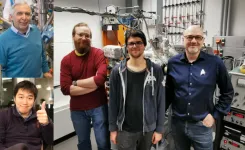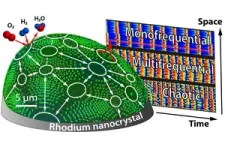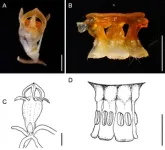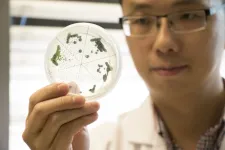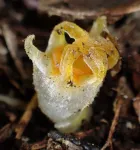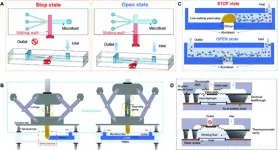(Press-News.org)
Chaotic behavior is typically known from large systems: for example, from weather, from asteroids in space that are simultaneously attracted by several large celestial bodies, or from swinging pendulums that are coupled together. On the atomic scale, however, one does normally not encounter chaos – other effects predominate. Now, for the first time, scientists at TU Wien have been able to detect clear indications of chaos on the nanometer scale – in chemical reactions on tiny rhodium crystals. The results have been published in the journal Nature Communications.
From inactive to active – and back again
The chemical reaction studied is actually quite simple: with the help of a precious metal catalyst, oxygen reacts with hydrogen to form water, which is also the basic principle of a fuel cell. The reaction rate depends on external conditions (pressure, temperature). Under certain conditions, however, this reaction shows oscillating behavior, even though the external conditions are constant. “Similar to the way a pendulum swings from left to right and back again, the reaction rate oscillates between barely perceptible and high, and thus the catalytic system oscillates back and forth between inactive and active states” explains Prof. Günther Rupprechter from the Institute of Materials Chemistry at TU Wien.
A pendulum is a classic example of something predictable – if you disturb it a bit or set it in motion twice in slightly different ways, it behaves broadly the same. In this sense, it is the opposite of a chaotic system, where minimal differences in the initial conditions lead to strongly differing results in the long-term behavior. A prime example of this behavior are several pendulums connected by elastic bands.
Setting exactly the same initial conditions twice is impossible
"In principle, of course, laws of nature still determine exactly how pendulums behave," says Prof. Yuri Suchorski (TU Wien). "If we could start such a coupled system of pendulums in exactly the same way twice, the pendulums would move exactly the same way both times." But in practice, that's impossible: you'll never be able to perfectly recreate the same initial situation the second time as you did the first - and even a vanishingly small difference in the initial conditions will cause the system to behave completely different than the first time - this is the famous "butterfly effect": small differences in the initial conditions lead to huge differences in the state at a later time.
Something very similar has now been observed during chemical oscillations on a rhodium nanocrystal: "The crystal consists of many different surface nanofacets, like a polished diamond, but much smaller, on the order of nanometers," explain Maximilian Raab and Johannes Zeininger, who performed the experiments. "On each of these facets, the chemical reaction oscillates, but the reactions on neighboring facets are coupled."
Switching - from order to chaos
The coupling behavior can now be controlled in a remarkable way - by changing the amount of hydrogen. Initially, one facet dominates and sets the pace like a pacemaker. All other facets join in and oscillate to the same beat. If one increases the hydrogen concentration, the situation becomes more complicated. Different facets oscillate with different frequencies - but still their behavior is periodic and well predictable. However, if one then increases the hydrogen concentration further, this order suddenly breaks down. Chaos wins, the oscillations become unpredictable, small differences in the initial situation lead to completely different oscillation patterns - a clear sign of chaos.
"This is remarkable because you wouldn't really expect chaotic behavior in nanometer-sized structures," says Yuri Suchorski. “The smaller the system, the greater the contribution of stochastic noise. In fact, the noise, which is something completely different from chaos, should dominate the behavior of the system: it is even more interesting that it was possible to "extract" indications of chaos”. A theoretical model was particularly useful, developed by Prof. Keita Tokuda (University Tsukuba).
Chaos research applied to nano-chemistry
"Research on chaos theory has been going on for decades, and it has already been successfully applied to chemical reactions in larger (macroscopic) systems, but our study is the first attempt to transfer the extensive knowledge from this field to the nanometer scale," says Günther Rupprechter. "Small deviations in the symmetry of the crystal can determine whether the catalyst behaves in an ordered and predictable way or in a disordered and chaotic way. This is important for different chemical reactions - and perhaps even for biological systems."
END
The most recent generation of chatbots has surfaced longstanding concerns about the growing sophistication and accessibility of artificial intelligence.
Fears about the integrity of the job market — from the creative economy to the managerial class — have spread to the classroom as educators rethink learning in the wake of ChatGPT.
Yet while apprehensions about employment and schools dominate headlines, the truth is that the effects of large-scale language models such as ChatGPT will touch virtually every corner of our lives. ...
(Boston)—Many pregnancy complications are associated with future heart disease. Such complications include gestational diabetes, preterm birth, fetal growth restriction and hypertensive disorders of pregnancy (gestational hypertension, preeclampsia and related disorders), and together they are referred to as adverse pregnancy outcomes (APOs). Although APOs are recognized as a useful way to identify individuals with increased risk for future heart disease, it is not known how often APOs occur before traditional heart ...
New Orleans, LA – A study led by Vinod Dasa, MD, Professor of Orthopaedics at LSU Health New Orleans School of Medicine, reports that a novel surgical pain management strategy following total knee arthroplasty (TKA), or total knee replacement, provided pain relief without opioids. The researchers also found that changing prescriptions for opioids at discharge from automatic to upon request dramatically decreased opioid use. Their results are published in the Journal of Experimental Orthopaedics, available here.
“About 70% of opioid-naïve ...
New award from the U.S. Dept. of Energy will help researchers develop green technology to capture carbon dioxide emissions from power plants
BALTIMORE, MD (February 27, 2022)—Researchers from the University of Maryland Center for Environmental Science (UMCES) and the Institute of Marine and Environmental Technology (IMET) have been awarded a three-year, $2 million grant from the U.S. Department of Energy to understand how microalgae can be used to reduce carbon dioxide emissions from power plants.
“Climate change is one of the biggest challenges facing our society today and IMET is thrilled ...
Green leaves and photosynthesis were once considered key features of plants. However, some plants have since abandoned this process, obtaining their nutrients from other organisms. One such plant is the genus of Thismia, commonly known as fairy lanterns, which is characterised by its unusual appearance, elusiveness, and lack of photosynthesis. Fairy lanterns are rare and only grow in specific places. They live underground with their colourful flowers rising above the soil, which can sometimes make them look like mushrooms. Around 90 species of Thismia have been found, but many are ...
INDIANAPOLIS – Despite awareness that pain is common in nursing home residents, there has been minimal attention focused on how this pain changes over time. A new study from Regenstrief Institute and Indiana University School of Nursing researchers presents compelling evidence of the existence of four distinct pain trajectories in this population.
This new understanding of pain over time can help nursing home staff and clinicians better understand, recognize and respond to risk factors associated with persistent pain in individuals living in nursing homes. Ultimately, consideration of pain trajectories may alter courses of care and illness, ...
The use of space environment to carry out life science research is of great significance to issues affecting the occurrence and development of life on earth by space flight and space environment; however, there are limitations in complex manipulation, research models based on mammalian and 2D cell culture experiments, and etc. Microfluidic chips, also known as "lab-on-chip (LOC)", integrates the related functions of traditional laboratories on a micron-level chip with low energy consumption, high throughput, and automation, which can realize long-term experimental operation, and remote data recording and transmission, thus ...
What the United States midterm election results revealed about the current state of democracy in the country – and the challenges that might lie ahead for both major parties – is examined in a new report led by a politics expert from London's Kingston University.
Academics from institutions across the United Kingdom, United States and the Republic of Ireland have contributed to the Exploring the 2022 US Midterms briefing paper, recently published by the American Politics Group of the Political Studies Association. The report is designed to act as a bridge ...
People whose savings goals align well with their dominant personality traits are more likely to save money, according to research published by the American Psychological Association.
In the U.S. and around the world, savings rates are critically low. In October 2022, the Bureau of Economic Analysis reported Americans save just 2.3% of their income, the lowest in nearly two decades. Although people report wanting to save more money, saving is difficult -- in part because it requires people to overcome the psychological hurdle of making a sacrifice in the present to ...
COLUMBUS, Ohio – A new study may reveal part of the reason why conservatives are more likely than liberals to reject some COVID-19 health measures: They see boundaries as restrictions.
Liberals were more likely to see some of the measures used in the pandemic – such as social distancing rules and plexiglass separators in restaurants and stores – as providing guidance, rather than restrictions.
“There seems to be a fundamental ideological difference in how people view boundaries,” said Selin Malkoc, co-author of the study and professor of marketing at The Ohio State University’s Fisher College of Business.
“Conservatives ...
